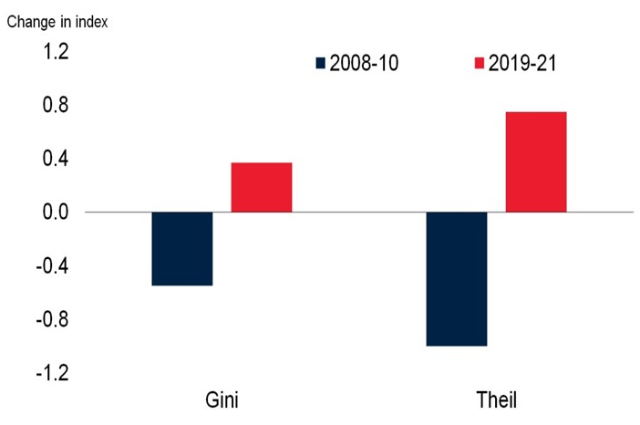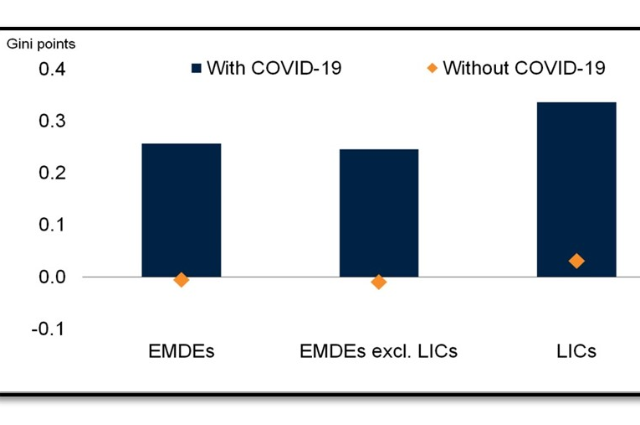
In 2020, the world saw one of its worst periods as a result of the pandemic Covid-19 brought on by the Coronavirus. The Corona Virus Disease 2019 (COVID-19), which started in Wuhan, China, was caused by a new coronavirus known as Severe Acute Respiratory Syndrome Corona Virus 2 (SARS-CoV-2). Nationwide lockdowns were ordered in most of the countries all over the world. According to specialists in the health industry, this lockdown is crucial for halting the spread of sickness. However, it was never envisioned that the 21-days lockdown would stretch up to a year and continue until 2021. Everything around us has changed due to COVID-19. The epidemic caused a significant number of deaths around the world. Every region of the world was swamped with the cries of defenceless families. Standing in 2022, it is still obvious that the crisis' long-term effects will be profound. Unprecedented in recent memory, the COVID-19 worldwide pandemic has caused a human and economic disaster. The world economy is in its greatest recession, which has disrupted supply chains, tourism, and other industries. Governments have reacted with lockdowns and stimulus plans, although the scope of these controls has varied globally. The most vulnerable groups within nations have been disproportionately impacted by both the spread of the virus and employment losses.
Millions of people have become infected by the COVID-19 pandemic, which has expanded at an alarming rate and almost halted economic activities as a result of governments' harsh travel restrictions designed to stop the virus' spread. The economic devastation is already clear and constitutes the worst economic shock the globe has seen in decades even as the health and human toll rises. The COVID-19 pandemic has had a significant impact on the world's economic and financial markets in addition to becoming a public health emergency on a worldwide scale. The effects of the disease mitigation measures that have been put in place in many nations include significant income decreases, an increase in unemployment, and disruptions in the transportation, service, and manufacturing industries. Deep recessions brought on by the epidemic are anticipated to have long-term effects due to diminished investment, a loss of human capital due to missed opportunities for employment and education, and the disintegration of international supply and trade networks. Moreover, the COVID-19 pandemic has had a direct impact on revenue due to early fatalities, decreased productivity, and workplace absenteeism. It has also generated a negative supply shock, with manufacturing activity slowing down as a result of supply chain disruptions throughout the world and factory closures. Consumers often modified their buying habits in addition to the effects on productive economic activities, mostly as a result of lower income and household finances as well as the fear and terror brought on by the outbreak. Due to the decline in travel, service sectors including tourism, hospitality, and transportation have seen major losses. Thus, many industrial, tourism, retail, and transport workers will suffer a significant reduction in work due to community restrictions and low demand for their goods and services. The COVID-19 pandemic will have an uneven economic impact across the country's income distribution in addition to pronounced health inequities, especially in nations lacking universal healthcare coverage.
An unprecedented worldwide macroeconomic catastrophe has been sparked by the COVID-19 shock. The subsequent policy actions and results were quite diverse, with the largest disparity between economies being characterised by access to financial resources, infrastructure, and strong health systems. The COVID-19 pandemic had a significant influence on the world's production and continues to do so. The per capita GDP of the global economy shrank in more than 90% of countries in 2020. With a -3.2 percent production reduction in 2020, the most recent World Economic Outlook (WEO) report from the IMF estimates that the recession is the deepest since the conclusion of World War II. This is a -6.6 percent loss in comparison to the IMF's +3.4 percent growth prediction from October 2019. As per the World Bank's most recent Global
Economic Prospects report the global economy is entering a marked slowdown after a strong recovery in 2021 due to new threats from COVID-19 variants as well as an increase in inflation, debt, and income inequality that could jeopardise the recovery in emerging and developing economies. It is predicted that global GDP would significantly slow from 5.5 percent in 2021 to 4.1 percent in 2022 and 3.2 percent in 2023 as pent up demand fades and global fiscal and monetary assistance is removed. The slowdown will occur when the gap between the growth rates of developed nations and emerging and developing economies widens. Advanced economies' growth is anticipated to slow from 5% in 2021 to 3.8% in 2022 and 2.3% in 2023, a rate that, while reducing, will be enough to return production and investment to these economies' pre-pandemic pattern. However, it is anticipated that growth in emerging and developing economies would slow from 6.3 percent in 2021 to 4.6 percent in 2022 and 4.4 percent in 2023. Although the output in emerging and developing economies will continue to be 4 percent behind its pre-pandemic level, all advanced economies will have fully recovered their output by 2023. The loss is considerably greater for many vulnerable economies: the production of small island nations and fragile and conflict-affected countries will be 8.5% and 7.5% respectively, below its pre-pandemic average. In the meanwhile, tightening monetary policy is caused by rising inflation, which is particularly harsh on low-income people. Inflation is at its highest levels since 2008 both globally and in industrialised nations. It has risen to its greatest level in developing and emerging market nations since 2011. Even before the recovery is fully underway, many emerging and developing economies are reducing policy assistance to reduce inflationary pressures. As a result of the COVID-19 pandemic's profound effects on global economic activity, economic inequality has increased.
Economic disparity is the uneven distribution of wealth and opportunities among various social groupings. Almost all nations in the world are concerned about it, and many people are stuck in poverty with little opportunities to move up the social scale. There are several viewpoints on economic inequality, all of which are connected. The most used indicator is income inequality, which measures how evenly income is distributed among a population. Since the 1990s, global inequality has been rapidly decreasing. Global inequality drastically rose over the nineteenth and the majority of the twentieth centuries, indicating growing gaps in per capita income between nations as rich economies boomed relative to the rest of the globe. The COVID-19 pandemic has made inequality already terrible. Over the past two to three decades, income and wealth inequality has increased in virtually all significant industrialised economies. A key issue of our day is growing inequality, which has negative effects on the economy, society, and politics. It has slowed productivity growth and dampened aggregate demand, which has slowed economic development. It has fueled populist nationalism, political divisiveness, and social unrest. Additionally, as the pandemic has shown, it has made society and the economy more susceptible to shocks. Because of the substantial employment and income losses among lower-income population groups, it is also predicted that withincountry income inequality in EMDEs (Emerging Market and Developing Economies) has expanded somewhat. As a result of interruptions to schooling brought on by the pandemic and the disproportionately negative impacts on low-income households, intergenerational mobility may deteriorate, the increase in intra-country inequality generated by the pandemic may become entrenched. The ability of nations to assist disadvantaged populations, promote recovery, and promote sustainable growth may be hampered by high inflation and soaring public debt levels. Significant employment and income losses among low-skilled employees, low-income households, informal workers, and women were contributing factors to the rise in intra-country inequality.
(i) Significant rise in between-country inequality
The COVID-19 epidemic threatens the reduction in global wealth disparity that has been made over the past 20 years. Contrary to the global financial crisis of 2008–10, the pandemic-induced severe recession and the advanced countries' slower economic recovery in EMDEs have increased income disparity across nations. According to several indicators, such as Gini and Theil indexes based on real GDP per capita, between-country inequality has returned to levels seen in the early 2010s.

(ii) Moderate rise in income disparity within countries for EMDEs
According to estimates, the pandemic increased income disparity among EMDEs, while the increase's overall size has been very minor. According to simulations for 34 EMDEs in the sample with enough data, income inequality as assessed by the Gini index increased in 2020 by 0.3 points, reversing the trend of declining inequality that has been seen in EMDEs since the 2000s. However, the increase's size is just marginally larger than the sample's prior two decades' yearly average drop in within-country inequality. Significant employment and income losses among low-skilled employees, low-income households, informal workers, and women were contributing factors to the rise in intra-country inequality.

While some inequality is unavoidable in a market-based economic system due to variations in skill, effort, and luck, excessive disparity might destroy social cohesion, cause political division, and eventually impede economic development. For these reasons, lowering income inequality is one of the primary worldwide issues in the post-pandemic age. In the years after the start of the global financial crisis, the IMF has further extended its work on inequality concerns. Government tax and spending policies, when properly crafted, may contribute to both better equality of outcomes and opportunities and higher growth. For instance, increasing access to fundamental health and education services and lowering obstacles to women entering the workforce can assist enhance development and achieve equitable goals. When creating budgetary consolidation packages, serious consideration should also be given to measures that are excellent for both equality and efficiency, such as an increase in recurrent property tax collection. Furthermore, meeting the Sustainable Development Goals depends on eliminating inequality and making sure no one is left behind. The goal of SDG 10 (Reduced Inequalities) is to lessen all forms of inequality globally. One way to address the problem of increasing income disparity is through achieving SDG 10.
To conclude, income inequality is inevitable but not permanent. Therefore, taking the right efforts to reduce economic disparity can have a positive effect. Vaccination, expansion in rural healthcare and cash transfers should be a part of the effort to boost demand and reduce income inequality. Further, along with a gap between the wealthy and the poor, income inequality also indicates a sizable difference between men and women. Looking at many data from the post-pandemic era, we can see that women and girls were most affected, thus addressing their conditions must be a top priority for the entire globe in order to eliminate wealth disparity and achieve sustainable development. Finally, because everything in an economy is related whether directly or indirectly, lowering economic inequality should be one of the main priorities for the post-pandemic age. This can be done if we concentrate on attaining gender equity globally, as it is the pillar for all other concerns.
